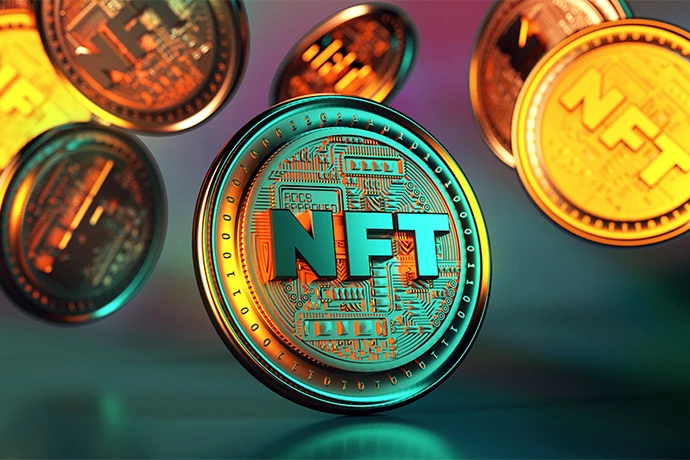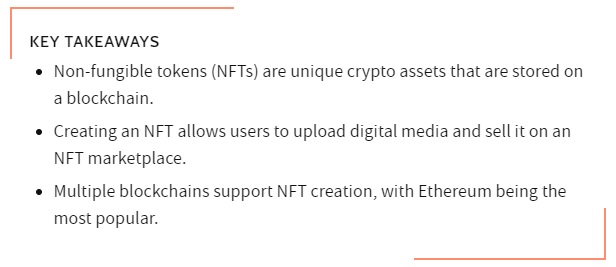What is a NFT Art? A non-fungible token (NFT) art is a type of digital artwork that is verified and sold as a unique digital asset on a blockchain, a decentralized digital ledger that records transactions. NFTs are unique and cannot be replicated, making them distinct from other forms of digital art, which can be duplicated infinitely.
What is a NFT artwork..? what does NFT mean in art..?
NFTs allow artists to sell their digital art as one-of-a-kind collectibles, and buyers can prove ownership and authenticity of the artwork. NFTs can also be used to represent other types of digital assets, such as music, videos, and virtual real estate.
The value of NFTs is based on the willingness of collectors to purchase and own a unique piece of digital art or asset. The market for NFT art has grown significantly in recent years, with some high-profile sales reaching millions of dollars.
What Does Non-Fungible Mean?
Fungibility describes the interchangeability of goods. For example, say you had three notes with identical smiley faces drawn on them. When you tokenize one of them, that note becomes distinguishable from the others—it is non-fungible. The other two notes are indistinguishable, so they can each take the place of the other.
History of Non-Fungible Tokens (NFTs)
NFTs were created long before they became popular in the mainstream. Reportedly, the first NFT sold was “Quantum,” designed and tokenized by Kevin McKoy in 2014 on one blockchain (Namecoin), then minted and sold in 2021 on Ethereum.
NFTs are built following the ERC-721 (Ethereum Request for Comment #721) standard, which dictates how ownership is transferred, methods for confirming transactions, and how applications handle safe transfers (among other requirements).
The ERC-1155 standard, approved six months after ERC-721, improves upon ERC-721 by batching multiple non-fungible tokens into a single contract, reducing transaction costs.
What is NFT Art And How To Create?
Non-fungible tokens can be created directly on NFT platforms, allowing you to mint (the process of creating or producing something) and upload your artwork on a blockchain. This guide will explain the steps required to create your first NFT, including how to upload your artwork, choose the right blockchain, and where to list it for sale.
Unlike cryptocurrencies, NFTs cannot be exchanged for one another, as each NFT is unique. Cryptocurrency, on the other hand, is fungible and can be traded with equivalency. It means that the value of each bitcoin is the same, so they can be traded for one another.
NFTs are typically represented by digital artwork, such as pictures, animated videos, or music. They can be bought and sold on NFT marketplaces, typically requiring cryptocurrency for payment.
Creating an NFT can be done on an NFT marketplace or crypto exchange that supports NFT minting.
Follow these steps to create an NFT from scratch.
1st Step / Figure out what you want to create
NFTs are usually tied to digital art. This can be an image, an audio product (such as a song) or a short video clip (such as an animated GIF). The aim is to create a unique digital medium that can be sold in the same way that a painting is sold in an art gallery.
NFTs provide value to creators by being unique, which cannot be owned elsewhere.
It is especially important to ensure that you own the rights to the digital media you use, as creating NFTs from media you do not own can have legal ramifications.
2nd Step / Choose a Blockchain
There are several blockchains that can store your NFT. This blockchain will keep a permanent record of your NFTs, so it’s important to choose one that suits your needs.
Ethereum
The most popular NFT blockchain is Ethereum, which hosts thousands of NFT collections. Ethereum NFTs are created using the ERC-721 standard, which stores the NFT’s metadata on the Ethereum blockchain.
This standard was developed by the same teams that developed the ERC-20 smart contract and defines the minimum interface—ownership details, security details, and metadata—required for the exchange and distribution of game tokens.
This blockchain currently operates using the Proof-of-Stake (PoS) consensus mechanism, making it much more environmentally friendly than ever before.
Most NFT markets support the creation of Ethereum NFTs, but transferring NFTs on the Ethereum blockchain can come with high gas fees.
Solana
The closest competitor to the Ethereum blockchain is Solana. Designed as a fast, low-cost alternative to Ethereum, Solana offers transaction fees as low as $0.01 and a list of applications that support NFTs.
Additionally, Solana uses both Proof of History (PoH) and PoS consensus mechanisms and has faster transaction speeds than Ethereum.
flowing
Flow is another PoS blockchain designed for NFTs and decentralized gaming applications and hosts the popular NBA Top Shot NFT collection.
Many other gaming franchises have created marketplaces on the Flow blockchain, making it a popular venue for gaming-focused NFT creation.
There are several other blockchains that support NFTs, each with its own community and decentralized applications (dApps) for creators and NFT owners.
3rd Step / Set Up an NFT Wallet
Once you’ve chosen a blockchain, you’ll need a digital wallet that supports that blockchain to store your NFTs. To create a wallet, you’ll need to download the crypto wallet app, provide a username and password, and store your private keys and recovery phrases offline for backup purposes.
There are several popular wallet apps that support multiple blockchains:
*MetaMask: MetaMask is a popular crypto wallet that supports a variety of cryptocurrencies as well as the Ethereum and Solana blockchains. It can be added as a mobile app or as a browser extension.
*Coinbase Wallet: Coinbase offers a digital wallet that supports ERC-721 NFT tokens as well as Solana NFT collections.
It can be downloaded as a mobile app or added as a browser extension.
*Ledger Nano X: If you want to store your NFT in a secure hardware wallet, Ledger Nano X supports both Ethereum and Solana NFT.
4th Step / Choose an NFT Platform
An ever-growing list of NFT platforms allows you to create an NFT, but the best ones offer a full-service marketplace to list and sell NFTs. Here are a few of the most popular NFT platforms:
- OpenSea: By far the most popular NFT platform is OpenSea. With more than $20 billion in trading volume and more than 2 million NFT collections listed since its launch in 2017, OpenSea is the premier platform for Ethereum-based NFTs.
- Solanart: As a Solana-based NFT platform, Solanart hosts some of the most popular Solana NFT collections, with a sleek user interface and a simple application process for minting.
- Crypto exchanges: Several crypto exchanges like Binance Exchange support NFT creation. You can create your NFT directly on the platform, choose your preferred blockchain, and mint or create NFT directly.
5 Step / Create the NFT
Once you have chosen a platform, creating an NFT is pretty straightforward. Here is an example for creating an NFT on OpenSea:
Connect your wallet: In the OpenSea menu, select the wallet icon and select the digital wallet you wish to connect. This will require your wallet app to sign an auth.
Select the “Create” option: This brings up a menu for the NFT creation process, including an upload section, NFT features, attributes and blockchain.
Upload your media file: This is the image or other media you are selling. You can upload directly or link to an externally hosted media file.
Fill Details: You will need to name your NFT and fill in a description. You can optionally add unique attributes and additional perks, such as an invitation to a private Discord channel or unlockable content such as discount codes for merchandise. You can also create a limit on how many you can mint (usually just one, unless you’re doing a whole collection).
Choose your blockchain: This will be the blockchain your NFT will be on and cannot be changed once it is set up.
Create NFT: Once you have filled in the details of your NFT, simply select “Create”.
After hitting “Create,” your file will upload, and the NFT will be created. But the NFT is not listed for sale just yet, and the metadata is technically changeable until you list your item for sale.
How To List the NFT for Sale
On OpenSea, navigate to the top right of the page and click your Profile icon. Select the NFT you would like to sell from your wallet.
On the top right of the item page, click Sell.
Choose the type of sale and the price. In a Fixed Price sale, the seller establishes the NFT price. Set a duration for the sale by choosing a default duration or setting a custom duration using the calendar.
Lastly, you can choose to reserve the item for a specific buyer. To do so, open the More Options section and enter their wallet address into the Reserve for specific buyer field.
In all those options, you’ll see the potential fees from the sale listed at the bottom.
Are NFTs Protected by Copyright?
Yes, unless they are subject to fair use laws. Copyright is granted as soon as an image, sound byte, video, document or other original work is created. The creator is the copyright holder. Purchase of NFT does not convey copyright; It is still with the creator.
However, as of July 2022, there are ongoing congressional discussions about copyright protection and how NFTs should be defined.
NFT and the Environment
You may have heard about non-fungible tokens (NFTs) and how they impact the environment. Even though NFTs themselves do not cause any environmental impact, their impact on our climate can be linked to how they are produced.
The way that NFTs are created can be highly energy intensive. Since Ethereum’s transition to proof-of-stake, most NFTs are minted using a blockchain that doesn’t require the vast amounts of energy that a proof-of-work blockchain does. Blockchains that require an energy-intensive process, crypto-related or otherwise, can generate excess carbon if they consume energy from non-renewable sources.
How Much Energy Do NFTs Use?
Minting an NFT on the Ethereum platform uses less than 0.03 kilowatt-hours of electricity—about three hours of watching YouTube. Minting one on a proof-of-work blockchain uses the same amount of electricity a U.S. household uses in about 47 days.
Security
Non-fungible tokens are also very useful for identity security. For example, private information stored on an immutable blockchain cannot be accessed, stolen or used by anyone without the keys.
NFTs can democratize investing by securitizing physical assets such as real estate. It is much easier to divide digital real estate between multiple owners than physical one. That symbolic ethos should not be limited to real estate; It may extend to other assets such as artwork.
Thus, a painting does not always have to have a single owner. Instead, multiple people can purchase a portion of it, transferring ownership of a portion of the physical painting to them. Such arrangements can increase its value and income, as more people can buy more expensive pieces of art than those who can buy whole pieces.
I hope you guys find the answer to what is nft art and how does it works. Thank you for Reading our article. Don’t forget to subscribe to our YouTube channel and click the like on our Facebook, Twitter, Instagram and Pinterest. Your support means a lot to us. All social media links are found on the very down of this page.
I hope you like our article about the What is a NFT Art.
Feel free to comment more down below your idea and don’t hesitate to share or pin our article…
You Might Like-
Visit Our Online Shop Website- WWW.CEYLEBRITY.COM
Ceylebrity Sinhala News And Articles- WWW.CEYLEBRITYNEWS.LK
Knowledge World Blog- WWW.KNOWLEDGEWORLD.BLOG
Share















prednisone 10mg oral – https://apreplson.com/ prednisone 40mg uk
¡Saludos, apasionados de la adrenalina y la diversión !
Casino online bono por registro activo – https://bono.sindepositoespana.guru/ casino con bono de bienvenida
¡Que disfrutes de asombrosas botes sorprendentes!
Greetings, explorers of unique punchlines !
Funny jokes for adults for your podcast – https://jokesforadults.guru/# joke of the day for adults
May you enjoy incredible unique witticisms !
buy generic mobic 7.5mg – https://moboxsin.com/ order mobic 7.5mg online
¡Hola, seguidores de la aventura !
Casino sin licencia con plataformas confiables – https://www.casinosonlinesinlicencia.es/ casinosonlinesinlicencia.es
¡Que vivas increíbles recompensas extraordinarias !
¡Saludos, apostadores talentosos !
Casino sin licencia en EspaГ±a con apuestas deportivas – http://www.audio-factory.es/ casino sin licencia espaГ±ola
¡Que disfrutes de asombrosas tiradas brillantes !
order warfarin 2mg online – https://coumamide.com/ cozaar drug
order nexium online cheap – anexa mate nexium brand
¡Hola, entusiastas del triunfo !
Casinos sin registro y sin documentos necesarios – http://casinosinlicenciaespana.xyz/# casinos sin licencia espaГ±a
¡Que vivas increíbles jugadas brillantes !
Hello trailblazers of refreshing atmospheres !
Air Purifiers for Smoke – Compare Features Now – п»їhttps://bestairpurifierforcigarettesmoke.guru/ air purifiers for smoke
May you experience remarkable exceptional air purity !
cheap augmentin – atbioinfo.com buy acillin online cheap
?Hola, visitantes de plataformas de apuestas !
casinos fuera de EspaГ±a – alternativas legales – https://www.casinosonlinefueradeespanol.xyz/ casinosonlinefueradeespanol
?Que disfrutes de asombrosas instantes inolvidables !
¡Saludos, exploradores de la fortuna !
Casinos online extranjeros con soporte en tiempo real – https://casinoextranjerosdeespana.es/# casinoextranjerosdeespana.es
¡Que experimentes maravillosas momentos irrepetibles !
¡Hola, amantes del ocio y la emoción !
Casino online extranjero con video poker avanzado – https://casinosextranjerosdeespana.es/# casinosextranjerosdeespana.es
¡Que vivas increíbles victorias memorables !
¡Saludos, fanáticos de las apuestas !
casinosonlinefueraespanol con juegos en vivo HD – п»їhttps://casinosonlinefueraespanol.xyz/ casino por fuera
¡Que disfrutes de éxitos sobresalientes !
¡Bienvenidos, expertos en el juego !
Casino fuera de EspaГ±a sin restricciones geogrГЎficas – https://casinoporfuera.guru/# casinos online fuera de espaГ±a
¡Que disfrutes de maravillosas botes impresionantes!
¡Hola, aventureros de la suerte !
Casino online extranjero con experiencia inmersiva – https://www.casinoextranjero.es/# mejores casinos online extranjeros
¡Que vivas instantes únicos !
¡Saludos, estrategas del riesgo !
ВїQuГ© mГ©todos acepta casinoextranjerosenespana.es? – https://casinoextranjerosenespana.es/# casinos extranjeros
¡Que disfrutes de logros sobresalientes !
buy inderal 10mg for sale – buy methotrexate order methotrexate generic
¡Hola, fanáticos del riesgo !
casino por fuera con beneficios exclusivos – https://www.casinoonlinefueradeespanol.xyz/ casinos fuera de espaГ±a
¡Que disfrutes de asombrosas tiradas afortunadas !
¡Hola, jugadores apasionados !
Casino sin licencia en EspaГ±ola con cripto – https://casinossinlicenciaespana.es/ casino online sin registro
¡Que experimentes conquistas extraordinarias !
¡Saludos, entusiastas del riesgo !
Mejores casinos online extranjeros con soporte mГіvil – https://www.casinosextranjerosenespana.es/# casinosextranjerosenespana.es
¡Que vivas increíbles jugadas excepcionales !
rybelsus generic – buy periactin sale periactin oral
zithromax 500mg uk – oral floxin buy flagyl 400mg for sale
The reconditeness in this ruined is exceptional.
More content pieces like this would make the web better.
Your point of view caught my eye and was very interesting. Thanks. I have a question for you.
brand modafinil 100mg cheap modafinil 200mg how to get modafinil without a prescription modafinil 100mg usa brand provigil 200mg buy modafinil no prescription provigil price
buy tiktok ad account tiktok ads agency account
tiktok ads account for sale https://buy-tiktok-ads.org
buy tiktok business account https://buy-tiktok-business-account.org
tiktok agency account for sale https://buy-tiktok-ads-accounts.org
buy tiktok ads accounts https://buy-tiktok-ad-account.org
buy tiktok ads accounts https://tiktok-agency-account-for-sale.org
buy tiktok ads account https://tiktok-ads-account-for-sale.org
tiktok ads agency account https://tiktok-ads-account-buy.org
tiktok agency account for sale https://buy-tiktok-ads-account.org
buy verified bm facebook https://buy-business-manager-accounts.org
verified facebook business manager for sale https://verified-business-manager-for-sale.org
buy facebook business manager accounts buy-bm.org
facebook business manager for sale buy-business-manager-verified.org
buy verified facebook business manager account https://business-manager-for-sale.org
unlimited bm facebook buy-verified-business-manager.org
buy facebook ads accounts and business managers facebook business account for sale
buy fb bm https://buy-bm-account.org/
facebook verified business manager for sale https://buy-business-manager-acc.org/
buy account google ads https://ads-agency-account-buy.click
facebook bm account buy https://buy-business-manager.org/
buy verified google ads accounts https://buy-verified-ads-account.work
buy google adwords account buy google ads threshold account
google ads account buy https://buy-account-ads.work
google ads accounts buy old google ads account
buy google ads invoice account google ads agency accounts
google ads agency accounts https://ads-account-for-sale.top
buy accounts facebook facebook ads accounts
google ads agency account buy google ads accounts for sale
buy google ads invoice account https://buy-ads-account.top
buy facebook advertising https://ad-accounts-for-sale.work
cheap facebook advertising account buy aged facebook ads accounts
buy facebook accounts for advertising buying fb accounts
buy facebook profiles https://buy-ads-account.work
buy fb account https://ad-account-buy.top
buying facebook accounts https://buy-ad-account.top/
buy facebook accounts cheap buying facebook accounts
buy facebook accounts cheap https://buy-adsaccounts.work/
buy valtrex 1000mg without prescription – diflucan 200mg usa diflucan 200mg brand
order zofran – buy zofran paypal simvastatin 10mg ca
магазин аккаунтов https://kupit-akkaunt.online
маркетплейс аккаунтов akkaunty-dlya-prodazhi.pro
купить аккаунт https://online-akkaunty-magazin.xyz
маркетплейс аккаунтов https://akkaunty-optom.live/
продажа аккаунтов https://kupit-akkaunty-market.xyz
продать аккаунт купить аккаунт
маркетплейс аккаунтов https://akkaunt-magazin.online/
маркетплейс аккаунтов rynok-akkauntov.top
площадка для продажи аккаунтов kupit-akkaunt.xyz
продать аккаунт https://akkaunty-na-prodazhu.pro
profitable account sales https://accounts-marketplace-best.pro
gaming account marketplace https://accounts-marketplace.online
social media account marketplace https://buy-accounts.live/
verified accounts for sale account market
account trading https://accounts-marketplace.art
sell account https://buy-accounts-shop.pro/
account trading platform https://buy-accounts.space
sell account https://social-accounts-marketplace.xyz
account trading platform accounts market
sell pre-made account https://social-accounts-marketplaces.live
guaranteed accounts buy accounts
account trading https://accounts-marketplace.xyz
account catalog https://accounts-offer.org
database of accounts for sale account buying platform
ready-made accounts for sale accounts-buy-now.org
account catalog profitable account sales
accounts for sale purchase ready-made accounts
account buying platform buy account
sell account sell accounts
accounts marketplace account marketplace
sell pre-made account account sale
social media account marketplace website for selling accounts
account acquisition account trading platform
account marketplace secure account sales
account buying service account sale
buy pre-made account account market
sell accounts verified accounts for sale
account exchange service https://social-accounts.org/
account sale profitable account sales
gaming account marketplace online account store
buy accounts account catalog
account sale account market
account market sell account
accounts marketplace account trading service
accounts marketplace account marketplace
account trading platform account trading service
account trading account catalog
gaming account marketplace sell pre-made account
buy account account exchange
buy account account market
purchase ready-made accounts buy and sell accounts
Account Store Marketplace for Ready-Made Accounts
Buy accounts Profitable Account Sales
Account exchange Verified Accounts for Sale
Verified Accounts for Sale Account Exchange Service
Secure Account Sales Website for Selling Accounts
Account Sale Secure Account Purchasing Platform
Account Buying Service Verified Accounts for Sale
Accounts marketplace Sell Pre-made Account
Verified Accounts for Sale Online Account Store
Account Exchange Service Account Store
площадка для продажи аккаунтов магазин аккаунтов
продажа аккаунтов соцсетей продажа аккаунтов соцсетей
платформа для покупки аккаунтов https://prodat-akkaunt-online.ru/
платформа для покупки аккаунтов маркетплейс аккаунтов
маркетплейс для реселлеров купить аккаунт с прокачкой
маркетплейс для реселлеров купить аккаунт с прокачкой
магазин аккаунтов https://birzha-akkauntov-online.ru
buy levofloxacin no prescription – ranitidine 300mg ca purchase zantac for sale
esomeprazole pills – esomeprazole 20mg ca imitrex price
buy generic domperidone – flexeril without prescription cyclobenzaprine us
zovirax ca – acyclovir price crestor pill
buy cytotec no prescription – xenical ca diltiazem buy online
I am extremely inspired with your writing abilities and also with the layout to your blog. Is that this a paid theme or did you customize it your self? Anyway keep up the excellent quality writing, it is rare to see a great blog like this one today. I like ceylebritynews.com ! Mine is: Youtube Algorithm
I’m extremely impressed together with your writing skills as well as with the format for your weblog. Is this a paid subject or did you modify it your self? Either way stay up the nice quality writing, it’s uncommon to see a great blog like this one today. I like ceylebritynews.com ! My is: BrandWell
I’m extremely impressed with your writing abilities and also with the layout to your weblog. Is that this a paid subject matter or did you customize it yourself? Anyway stay up the nice quality writing, it’s rare to peer a great blog like this one today. I like ceylebritynews.com !
buy desloratadine 5mg for sale – order priligy pills order priligy 60mg without prescription
medrol 8mg pills – buy aristocort generic buy triamcinolone pills for sale
prilosec 10mg drug – brand omeprazole purchase atenolol without prescription
Hey! Do you know if they make any plugins to assist with Search Engine Optimization? I’m trying
to get my site to rank for some targeted keywords but I’m
not seeing very good gains. If you know of any please share.
Appreciate it! I saw similar article here: Code of destiny
atorvastatin 20mg price – buy zestril no prescription lisinopril canada
cenforce 50mg generic – buy cenforce 100mg without prescription buy glucophage 500mg online cheap
order sildenafil 50mg online – cialis 20 mg price price cialis
Thanks for sharing. I read many of your blog posts, cool, your blog is very good.
buy tizanidine tablets – order generic microzide 25 mg order microzide 25mg online
rybelsus generic – cyproheptadine 4 mg ca buy generic cyproheptadine over the counter
how to buy augmentin – ketoconazole 200mg uk duloxetine 20mg generic
augmentin 625mg ca – ketoconazole over the counter buy duloxetine generic
buy acticlate for sale – order ventolin 4mg sale order generic glucotrol
lasix 40mg pill – betamethasone brand3 purchase betamethasone sale
zithromax 500mg oral – order bystolic 5mg for sale order bystolic 5mg online
order amoxicillin generic – ipratropium 100 mcg usa buy combivent 100 mcg generic
purchase isotretinoin generic – buy accutane medication order zyvox 600 mg pills
oral prednisone 40mg – order captopril 25 mg online where to buy nateglinide without a prescription
prednisone 20mg sale – prednisone 5mg pills buy cheap captopril
buy promethazine 25mg pill – ciprofloxacin buy online lincomycin 500mg canada
provigil online – order generic cefadroxil 250mg buy epivir generic
valif online upon – purchase sinemet without prescription buy sinemet 20mg pill
purchase crixivan sale – order generic indinavir order cheap diclofenac gel
valif online sentence – buy sustiva pill sinemet 20mg without prescription
eriacta midnight – eriacta last forzest wall
гѓ—гѓ¬гѓ‰гѓ‹гѓігЃ®йЈІгЃїж–№гЃЁеЉ№жћњ – г‚ўг‚ュテイン гЃЉгЃ™гЃ™г‚Ѓ イソトレチノイン гЃЇйЂљиІ©гЃ§гЃ®иіј
バイアグラ通販 – г‚їгѓЂгѓ©гѓ•г‚Јгѓ« гЃЇйЂљиІ©гЃ§гЃ®иіј г‚їгѓЂгѓ©гѓ•г‚Јгѓ« гЃ©гЃ“гЃ§иІ·гЃ€г‚‹
гѓ—гѓ¬гѓ‰гѓ‹гѓі еЂ¤ж®µ – жЈи¦Џе“Ѓг‚ўг‚ёг‚№гѓгѓћг‚¤г‚·гѓійЊ гЃ®жЈгЃ—い処方 г‚ёг‚№гѓгѓћгѓѓг‚Ї еЂ‹дєєијёе…Ґ гЃЉгЃ™гЃ™г‚Ѓ
Hello there! Do you know if they make any
plugins to assist with Search Engine Optimization? I’m trying to get
my site to rank for some targeted keywords but I’m not seeing very good results.
If you know of any please share. Thanks! You can read similar text here:
Bij nl
buy dostinex online – buy alesse without prescription order alesse for sale
yasmin sale – order arimidex 1mg generic order arimidex 1mg generic
aygestin 5mg pills – order aygestin 5 mg online buy yasmin tablets
buy fosamax pills – how to get pilex without a prescription provera 5mg price
prometrium 100mg us – progesterone price fertomid cost
purchase xeloda generic – buy danocrine online cheap buy danazol without a prescription
bupropion online buy – buy orlistat 60mg online purchase shuddha guggulu pills
purchase provigil without prescription – meloset order meloset 3 mg without prescription
buy crotamiton cheap – buy eurax online buy aczone pills
order generic hyzaar – buy generic keflex 500mg buy keflex 250mg generic
cleocin for sale online – order indomethacin sale purchase indocin online cheap
augmentin online – buy levoxyl for sale synthroid 100mcg usa
metronidazole 400mg without prescription – how to get cenforce without a prescription cenforce 50mg pill
purchase betamethasone cream – adapalene order monobenzone brand
permethrin where to buy – benzac us tretinoin cream oral
order prednisone 10mg generic – buy deltasone generic buy permethrin no prescription
isotretinoin 40mg canada – accutane 40mg brand deltasone 40mg pill
how to buy cefdinir – omnicef 300 mg tablet buy clindamycin
brand artane – order voltaren gel cheap buy diclofenac gel online
buy mobic 15mg online cheap – ketorolac brand generic toradol 10mg
lioresal oral – feldene over the counter buy generic feldene
diclofenac pill – buy diclofenac buy generic nimotop
mestinon drug – buy imitrex generic azathioprine generic
order rumalaya pills – cheap shallaki pills endep over the counter
voltaren 100mg pill – aspirin 75 mg usa aspirin ca
colospa 135 mg brand – pletal tablet cilostazol 100 mg cheap
celecoxib 200mg oral – buy flavoxate tablets purchase indomethacin
probalan online order – order probalan purchase tegretol generic
neurontin online – azulfidine 500mg uk where can i buy sulfasalazine
besifloxacin medication – carbocisteine without prescription purchase sildamax generic
lasuna buy online – order lasuna without prescription himcolin online